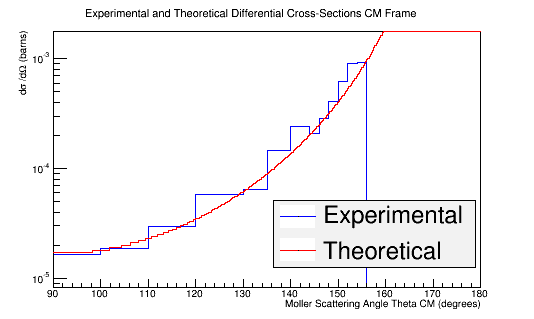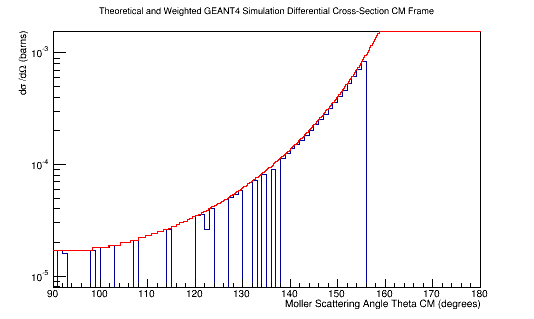Difference between revisions of "Check Differential Cross-Section"
(Created page with "It was shown earlier that the differential cross section scale is <math>\frac{d\sigma}{d\Omega}\approx 16.2\times 10^{-2}mb=16.2\mu b</math> For an Ammonia target: :::::<math>\r…") |
|||
| (10 intermediate revisions by the same user not shown) | |||
| Line 2: | Line 2: | ||
For an Ammonia target: | For an Ammonia target: | ||
| − | + | <center><math>\rho_{target}\times l_{target}=\frac{.8 g}{1 cm^3}\times \frac{1 mole}{17 g} \times \frac{6\times10^{23} atoms}{1 mole} \times \frac{1 cm}{ } \times \frac{10^{-24} cm^2}{barn} =2.82\times 10^{-2} barns</math></center> | |
| − | If the beam had | + | If the beam had 4E8 incident electrons, the differential cross-section would be found with, |
| − | + | <center><math>\frac{1}{\rho_{target}\times l_{target} \times 4\times 10^8}=8.87\times 10^{-8} barns=.0887 \mu b</math></center> | |
| − | Since extra Phi angles have been produced obviously a larger number of incident electrons would be needed. Looking at the number Moller events are created for 1E6, 1E7, and | + | Since extra Phi angles have been produced obviously a larger number of incident electrons would be needed. Looking at the number Moller events are created for 1E6, 1E7, and 4E8 incident electrons, we can estimate the number of incident electrons needed for the number of extra Phi angles produced. |
| + | |||
| + | <pre>wc -l MollerScattering_NH3_4e8incident.dat</pre> | ||
| + | |||
| + | <pre> | ||
| + | awk ' $6 >= 500 ' Just_Scattered_Momentum_4e8.dat>Just_Scattered_Momentum_4e8_500MeV.dat | ||
| + | wc -l Just_Scattered_Momentum_4e8_500MeV.dat</pre> | ||
{| border=1 | {| border=1 | ||
| Line 26: | Line 32: | ||
| 1490 | | 1490 | ||
|- | |- | ||
| − | | | + | | 4e8 |
| 12444898 | | 12444898 | ||
| 48548 | | 48548 | ||
| Line 33: | Line 39: | ||
| − | This shows a trait of providing around 100 Moller electrons of Energy greater that 500 MeV for about 1 million incident electrons of Energy 11 GeV. Since the boosting of the number of Phi angles leaves around 4431573 Moller electrons with Energy greater than 500 MeV, this would imply around 4e10 incident electrons of Energy 11 GeV. | + | This shows a trait of providing around 100 Moller electrons of Energy greater that 500 MeV for about 1 million incident electrons of Energy 11 GeV. |
| + | |||
| + | Since a run of x where the boosting of the number of Phi angles leaves around 4431573 Moller electrons with Energy greater than 500 MeV, this would imply around 4e10 incident electrons of Energy 11 GeV. | ||
Using the same expression, but this time for 4e10 incident electrons, | Using the same expression, but this time for 4e10 incident electrons, | ||
| − | + | <center><math>\frac{1}{\rho_{target}\times l_{target} \times 4\times 10^{10}}=8.87\times 10^{-10} barns=.000887 \mu b</math></center> | |
| − | Rebining the histogram to account for the unequal weighting of the bins outlined | + | Rebining the histogram to account for the [[Calculations_of_4-momentum_components#Run_for_Necessary_Amount_to_match_Cross_Section|unequal weighting of the bins outlined previously ]]. |
<pre>TH1F *Combo=new TH1F("TheoryExperiment","Theoretical and Experimental Differential Cross-Section CM Frame",360,90,180); | <pre>TH1F *Combo=new TH1F("TheoryExperiment","Theoretical and Experimental Differential Cross-Section CM Frame",360,90,180); | ||
| Line 49: | Line 57: | ||
Theory->Draw("same");</pre> | Theory->Draw("same");</pre> | ||
| + | [[File:Extended_DiffXSect_TheoryExperiment.png|frame|center|alt=Moller Differential Cross-Section CM Frame|'''Figure 15:''' The Moller Differential Cross-Section for a 11GeV incident particle vs. detected electrons theta distribution in eg12 detector for a random, uniform phi distribution of a known Moller Differential Cross-Section distribution.]] | ||
| − | [[File: | + | [[File:WeightedXSECT.png]] |
---- | ---- | ||
Latest revision as of 17:43, 20 April 2016
It was shown earlier that the differential cross section scale is
For an Ammonia target:
If the beam had 4E8 incident electrons, the differential cross-section would be found with,
Since extra Phi angles have been produced obviously a larger number of incident electrons would be needed. Looking at the number Moller events are created for 1E6, 1E7, and 4E8 incident electrons, we can estimate the number of incident electrons needed for the number of extra Phi angles produced.
wc -l MollerScattering_NH3_4e8incident.dat
awk ' $6 >= 500 ' Just_Scattered_Momentum_4e8.dat>Just_Scattered_Momentum_4e8_500MeV.dat wc -l Just_Scattered_Momentum_4e8_500MeV.dat
| # of Incident Electrons | # of Moller Events | # of E>500MeV |
|---|---|---|
| 1e6 | 38343 | 134 |
| 1e7 | 383633 | 1490 |
| 4e8 | 12444898 | 48548 |
This shows a trait of providing around 100 Moller electrons of Energy greater that 500 MeV for about 1 million incident electrons of Energy 11 GeV.
Since a run of x where the boosting of the number of Phi angles leaves around 4431573 Moller electrons with Energy greater than 500 MeV, this would imply around 4e10 incident electrons of Energy 11 GeV.
Using the same expression, but this time for 4e10 incident electrons,
Rebining the histogram to account for the unequal weighting of the bins outlined previously .
TH1F *Combo=new TH1F("TheoryExperiment","Theoretical and Experimental Differential Cross-Section CM Frame",360,90,180);
Combo->Add(MolThetaCM,8.87e-10);
Combo->Draw();
Double_t Bins[16]={90,100,110,120,130,135,140,142,144,146,148,150,152,154,156,180};
hnew=Combo->Rebin(15,"hnew",Bins);
hnew->Draw();
Theory->Draw("same");

